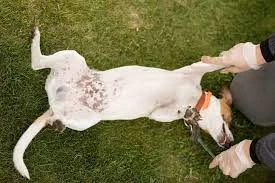Discovering brown spots on your dog\'s belly can be concerning for pet owners. While these spots may not always indicate a serious health issue, understanding their potential causes and knowing when to seek veterinary advice is essential for ensuring your dog\'s well-being. Brown Spots on Dog\'s Belly This article aims to shed light on the various factors that can contribute to the development of brown spots on a dog\'s belly and provide guidance on appropriate care and management.
Causes:
Hyperpigmentation: Some dogs may develop brown spots on their belly due to natural variations in skin pigmentation. This is often more common in breeds with darker fur and is usually harmless.
Contact Dermatitis: Exposure to irritants or allergens can lead to inflammation and discoloration of the skin. Dogs may develop brown spots on their belly as a result of contact dermatitis caused by substances such as chemicals, plants, or grooming products.
Allergic Reactions: Dogs can experience allergic reactions to certain foods, medications, or environmental triggers. In some cases, these allergies can manifest as brown spots on the skin, accompanied by itching, redness, or inflammation.
Infections: Fungal or bacterial infections can cause changes in skin color and texture. Dogs may develop brown spots on their belly as a result of infections such as ringworm or bacterial folliculitis.
Hormonal Imbalances: Hormonal fluctuations, such as those seen in conditions like Cushing\'s disease or hypothyroidism, can affect the pigmentation of a dog\'s skin, leading to the development of brown spots.
Age-related Changes: As dogs age, they may experience changes in skin pigmentation and texture. Brown spots on the belly can be a normal part of the aging process in some dogs.
Care and Management:
Veterinary Evaluation: If you notice brown spots on your dog\'s belly, it\'s essential to have them examined by a veterinarian. A thorough physical examination and possibly diagnostic tests may be needed to determine the underlying cause of the spots.
Allergy Testing: If allergies are suspected as the cause of the brown spots, your veterinarian may recommend allergy testing to identify potential triggers. Avoiding exposure to allergens and implementing appropriate treatment measures can help manage symptoms.
Skin Care: Practicing good skin care can help prevent and alleviate brown spots on your dog\'s belly. This includes regular grooming, using gentle and hypoallergenic grooming products, and keeping your dog\'s belly clean and dry.
Treatment of Underlying Conditions: Treatment for brown spots on a dog\'s belly will depend on the underlying cause. This may involve medications such as antifungals or antibiotics for infections, topical creams for skin inflammation, or hormone therapy for hormonal imbalances.
Monitoring and Follow-up: Keep an eye on your dog\'s skin and monitor for any changes in the appearance or behavior of the brown spots. Follow your veterinarian\'s recommendations for follow-up care and monitoring to ensure that your dog\'s skin remains healthy.
Conclusion:
Brown spots on a dog\'s belly can be a cause for concern, but they are often manageable with proper care and veterinary attention. By understanding the potential causes of these spots and taking proactive steps to address them, pet owners can help ensure the health and comfort of their furry companions. If you notice any changes in your dog\'s skin or behavior, don\'t hesitate to consult with your veterinarian for guidance and support.



